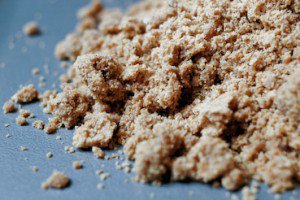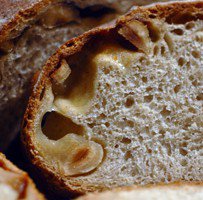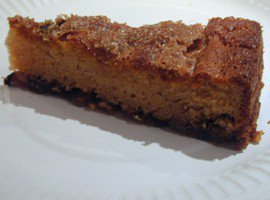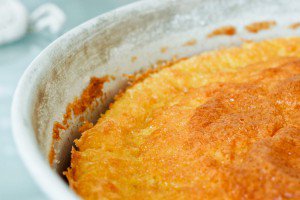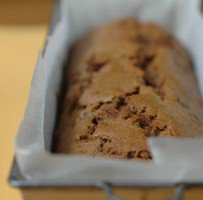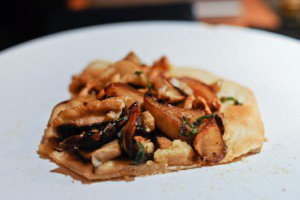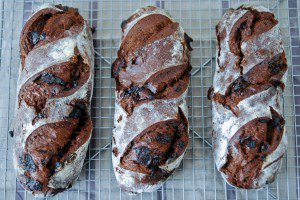I had lunch with my friends Pascale and Caroline a couple of weeks ago, and afterward we followed Caroline back to her apartment so she could share samples of a quirky ingredient she’d just laid her hands on: hazelnut flour.
I had initially thought she was referring to finely ground hazelnuts (hazelnut meal or poudre de noisettes), but no: this is made by grinding hazelnuts finely, yes, but also removing the oil they contain, until you’re left with a delicate powder, light brown in color and supernally fragrant.
I walked home with the package of hazelnut flour pulsing with possibilities in my purse, and halfway up the hill I had decided I would bake this rustic cherry and hazelnut loaf cake.
I walked home with the little package pulsing with possibilities in my purse, and halfway up the hill I had decided what I wanted to do with it: I bought sweet cherries at the produce stall around the corner, and baked this rustic cherry and hazelnut loaf cake. Nutty, moist, and dotted with soft morsels of cherry, it did not last for long on the kitchen counter.
I elaborated on the basic formula for sweet loaf cakes that Florence laid out on her blog: it incorporates a portion of sourdough starter into the batter, and it is one of those recipes that starter bread bakers yearn for, as we are always looking for ways to use up the extra starter that the keeping of a healthy colony produces. You do not need starter to make this cake, though; the two options are outlined in the recipe below.
The hazelnut “flour” I mentioned above is made by a French manufacturer of stone-ground nut oils that once had the idea to give a second life to the round cake of pressed nut meat that remains after the oil has been completely drawn out of it. This byproduct was formerly sold to serve as cattle feed or fish bait (!) but they realized it was perhaps a case of de la confiture pour les cochons (literally, “jam for pigs,” the French version of “pearls for swine”) the day one of their clients asked if he could buy it for his own cooking needs.
They are only selling this flour to professionals for now (my friend Caroline obtained it through a chef friend of hers), so I can’t give a source for it at this time, but if you ever stumble upon something similar, you have a recipe in which to use it. And if you’re unable to find it, regular ground hazelnuts will work just as nicely, as will chestnut flour if you have some lying around.
In passing, let me share a simple tip regarding the melting of butter for baking recipes: instead of zapping it in the microwave oven (I no longer have one), I place the required amount of butter in the baking pan I’m going to use (or in an ovenproof ramekin if it’s a pan with a removable bottom), and place it in the preheating oven. After two or three minutes (I set a timer so I don’t forget) the butter is almost completely melted, and will continue to melt from the residual heat. I set the pan or ramekin aside for the butter to cool slightly, then pour it into the batter as needed, and use a pastry brush to spread the remaining traces of butter around the bottom and sides of the pan to grease it. And that, ladies and gentlemen, was my time-and-energy-saving tip of the day.

Have you tried this? Share your pics on Instagram!
Please tag your pictures with #cnzrecipes. I'll share my favorites!
Ingredients
- 125 grams (1/2 cup plus 2 tablespoons) unrefined cane sugar
- 3 eggs, at room temperature
- 1 teaspoon pure vanilla extract
- 80 grams (6 tablespoons) butter, melted (if you use semi-salted like I do, omit the salt below)
- 60 ml (1/4 cup) plain yogurt or buttermilk (see note)
- 200 grams (7 ounces, about 1 2/3 cups) flour (see note)
- 100 grams (1 cup) hazelnut flour or finely ground hazelnuts (see note below to make your own)
- 1 teaspoon baking powder
- 1/2 teaspoon baking soda
- a pinch salt
- 350 grams (12 ounces, about 2 1/2 cups) sweet cherries, pitted (please wear an apron when you pit cherries, it is a murderously messy task; you can also use frozen cherries, no need to thaw them)
Instructions
- Preheat the oven to 200°C (400°F) and grease a loaf pan (mine is 9x26 cm or 3 1/2-by-10 1/4-inch). You can line it with parchment paper instead if you prefer.
- In a large mixing bowl, whisk together the sugar, eggs, and vanilla until frothy. Add the melted butter and the yogurt (or the starter, if using) and whisk again. (If using yogurt/buttermilk, the mixture may look curdled at this point; it's nothing to worry about.)
- In another mixing bowl, combine the flour, ground hazelnuts, baking powder, baking soda, and salt, and stir with a whisk to remove any lump. Add the cherries and toss to coat.
- Pour the flour/cherry mixture into the wet ingredients, and fold in gently with a spatula until no trace of flour remains. The batter will be thick and lumpy; don't overwork it. Pour into the prepared loaf pan, level the surface, and put into the oven to bake.
- Bake at 200°C (400°F) for 15 minutes, then lower the heat to 180°C (360°F) and bake for another 30 minutes, or until a cake tester inserted in the center comes out clean. Transfer to a rack to cool for 15-20 minutes before unmolding; run a knife along the sides to loosen the cake first. Let cool completely on the rack.
Notes
- If you want to use up some of your 100% starter (see post on natural starter bread to see what that means), use 120 grams (4 1/4 ounces) of it: omit the yogurt, use only 140 grams (5 ounces) flour, and add the starter in place of the yogurt in the instructions below.
- Hazelnut meal (finely ground hazelnuts) is a common baking ingredient in France, and is available from most supermarkets. To make your own, you'll need a food processor or blender: combine 100 grams (3/4 cup) whole hazelnuts with 2 tablespoons of the sugar that's called for in the recipe, and process in short pulses (it will be scary loud but that's okay) until finely ground.



